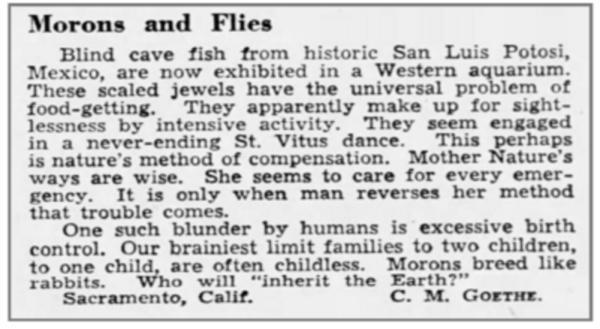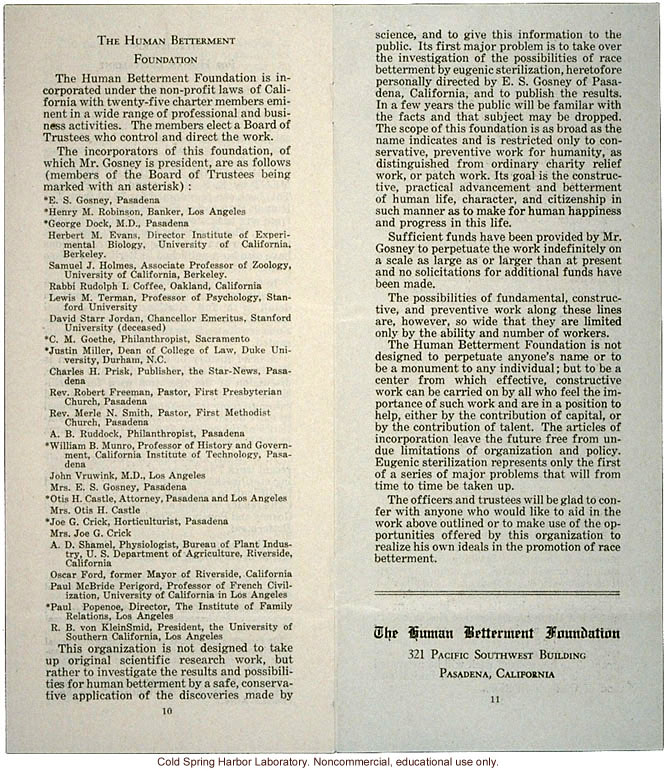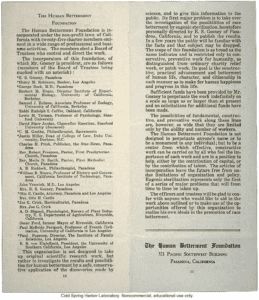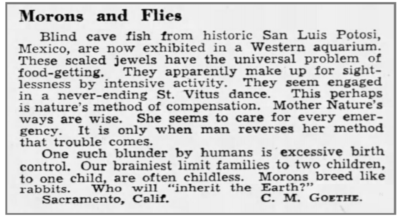In her remarks to Emily Bazelon, which I linked to on Sunday, Justice Ruth Bader Ginsburg said the following regarding Roe v. Wade, a feminist legal agenda and population control:
Q: If you were a lawyer again, what would you want to accomplish as a future feminist legal agenda?
JUSTICE GINSBURG: Reproductive choice has to be straightened out. There will never be a woman of means without choice anymore. That just seems to me so obvious. The states that had changed their abortion laws before Roe [to make abortion legal] are not going to change back. So we have a policy that affects only poor women, and it can never be otherwise, and I don’t know why this hasn’t been said more often.
Q: Are you talking about the distances women have to travel because in parts of the country, abortion is essentially unavailable, because there are so few doctors and clinics that do the procedure? And also, the lack of Medicaid for abortions for poor women?
JUSTICE GINSBURG: Yes, the ruling about that surprised me. [Harris v. McRae — in 1980 the court upheld the Hyde Amendment, which forbids the use of Medicaid for abortions.] Frankly I had thought that at the time Roe was decided, there was concern about population growth and particularly growth in populations that we don’t want to have too many of. So that Roe was going to be then set up for Medicaid funding for abortion. Which some people felt would risk coercing women into having abortions when they didn’t really want them. But when the court decided McRae, the case came out the other way. And then I realized that my perception of it had been altogether wrong.
Except she wasn’t “altogether wrong” — at least she wasn’t wrong about Roe v. Wade being “set up for Medicaid funding” and population control. Surrounding late 1960s and through the 70s, there was much public debate about the “population explosion.” In 1965, Griswold v. Connecticut struck down a law banning contraceptives. This case helped to establish the right to privacy as based in the Constitution which, in turn, was basis for Roe v. Wade.
As an example of the zeitgeist of the time, here are some excerpts from the 1972 Rockefeller Commission Report on Population Growth and the American Future. The Commission recommended that
…present state laws restricting abortion be liberalized along the lines of the New York statute, such abortion to be performed on request by duly licensed physicians under conditions of medical safety. In carrying out this policy, the Commission recommends:
That federal, state, and local governments make funds available to support abortion services in states with liberalized statutes.
That abortion be specifically included in comprehensive health insurance benefits, both public and private.
Sarah Weddington, co-counsel with her husband Ron Weddington, submitted this report as a part of her brief supporting Roe. Ron Weddington’s views were more pointed. He wrote then President-elect Clinton in 1992 and advised the president-to-be that traditional Democratic programs would not be effective unless Clinton started “immediately to eliminate the barely educated, unhealthy, and poor segment of our country.” How did Weddington propose to implement this draconian suggestion? He wrote to Clinton:
No I’m not advocating some kind of mass extinction of these unfortunate people. Crime, drugs and disease are already doing that. The problem is that their numbers are not only replaced but increased by the birth of millions of babies to people who cannot afford to have babies.
There I’ve said it. It’s what we all know is true, but we only whisper it, because we are liberals who believe in individual rights, we view any programs which might treat the disadvantaged as discriminatory, mean-spirited and well…so Republican.
…government is going to have to provide vasectomies, tubal ligations and abortions…RU486 and conventional abortions.
Weddington ended his letter with more words of sympathy for the children of poor families—and the need to prevent their existence:
We don’t need more cannon fodder. We don’t need more parishioners. We don’t need more cheap labor. We don’t need more poor babies.
So where Ginsburg was altogether wrong was not in her understanding of one of the forces behind Roe v. Wade. Where she was wrong was in her understanding of the High Court in the subsequent decisions regarding public funding of abortion. In any case, Ginsburg has been a consistent champion of tax-payer funding for abortions, even when she thought one purpose of Roe was to curb growth of “populations that we don’t want to have too many of.”
For Weddington such a policy seemed to be “discriminatory, mean-spirited and well…so Republican.” However, Ginsburg views public financing of abortion as a way to reduce, what she perceives as, gender discrimination. Which is it?
One thing seems sure. The issue of public abortion funding is as current as now. Yesterday, the Senate Health, Education, Labor and Pensions Committee rejected a bid by GOP Senators to eliminate abortion as a benefit in any government subsidized health reform package. If abortion as a benefit survives, then it will no doubt be challenged in the courts, eventually reaching the Supreme Court.
Justice Ginsburg is ready.
UPDATE: Since it is relevant to the above topic, I want to include the entire article by Paul Kengor and I and posted at World magazine on 7/16/09. In it, we find more information about what Ginsburg may have meant by “populations that we don’t want to have too many of.”
Disturbing Declarations
As Sonia Sotomayor was readying for her confirmation hearings, The New York Times Magazine cast a loving gaze toward the lone female Supreme Court justice, Ruth Bader Ginsburg. In so doing, the Times inadvertently shed light on some remarkable thinking by Justice Ginsburg. Those thoughts are so bracing that they ought to upstage the abortion questions surrounding the Sotomayor nomination.
Ginsburg long ago declared her support for Roe v. Wade. Now, however, she has declared something more.
When the subject in her interview with the Times’ Emily Bazelon turned to abortion, Ginsburg said, “Reproductive choice has to be straightened out. There will never be a woman of means without choice anymore. . . . So we have a policy that affects only poor women, and it can never be otherwise, and I don’t know why this hasn’t been said more often.”
Bazelon then asked, “Are you talking about the distances women have to travel because in parts of the country, abortion is essentially unavailable, because there are so few doctors and clinics that do the procedure? And also, the lack of Medicaid for abortions for poor women?”
Ginsburg replied, “Yes, the ruling about that surprised me. [Harris v. McRae-in 1980 the court upheld the Hyde Amendment, which forbids the use of Medicaid for abortions.] Frankly I had thought that at the time Roe was decided, there was concern about population growth and particularly growth in populations that we don’t want to have too many of. So that Roe was going to be then set up for Medicaid funding for abortion. Which some people felt would risk coercing women into having abortions when they didn’t really want them. But when the court decided McRae, the case came out the other way. And then I realized that my perception of it had been altogether wrong.”
Ginsburg is correct in noting that concerns about population growth animated many of those who backed Roe v. Wade. For instance, Sarah Weddington, co-counsel in Roe, along with her then-husband, Ron, wrote in her book A Question of Choice that team Weddington submitted as evidence the controversial 1972 Rockefeller Commission Report on Population Growth and the American Future, which included a call for public funding of abortion.
As for Ron Weddington, his views are even more direct, as was evident in a January 1993 letter to President-elect Bill Clinton. Weddington advised Clinton to strive “immediately to eliminate the barely educated, unhealthy, and poor segment of our country.”
How did Weddington propose to implement this draconian suggestion? In his letter to Clinton, he candidly wrote, “[G]overnment is going to have to provide vasectomies, tubal ligations and abortions . . . RU486 and conventional abortions.”
Weddington ended his letter with more words of sympathy for the poor: “We don’t need more cannon fodder. We don’t need more parishioners. We don’t need more cheap labor. We don’t need more poor babies.”
A year later it was Clinton who appointed Ruth Bader Ginsburg to the Supreme Court. For Ginsburg, that path was paved with help from one of the Weddingtons. As Sarah Weddington said in a 2007 interview, “I’ve also known Ruth Bader Ginsburg for years, and helped her get her appointment.”
Thanks to The New York Times Magazine, it looks like the Weddingtons and Ginsburg may be kindred spirits more than we had realized.
In fact, the Times piece prompts us to reconsider previous Ginsburg statements relating to “populations” that the justice doesn’t “want to have too many of.”
For instance, in an April 6, 1984, address to the University of North Carolina School of Law, published in the North Carolina Law Review, Justice Ginsburg described a 1971 speech where she faced tough questions on abortion policy:
“The questions were pressed by black men. The suggestion, not thinly veiled, was that legislative reform and litigation regarding abortion might have less to do with individual autonomy or discrimination against women than with restricting population growth among oppressed minorities. The strong word ‘genocide’ was uttered more than once. It is a notable irony that as constitutional law in this domain has unfolded, women who are not poor have achieved access to abortion with relative ease; for poor women, however, a group in which minorities are disproportionately represented, access to abortion is not markedly different from what it was in pre-Roedays.”
Ironic indeed. Instead of reducing “cannon fodder and cheap labor” via abortion, as the Weddingtons of the world had hoped, the Supreme Court upheld congressional bans on federal funding of abortion. According to her recent interview, Ginsburg was surprised the court upheld such bans. She continues to lament the fact that government does not fund abortions. Why?
Ginsburg’s comments to The New York Times Magazine open a floodgate of disturbing questions regarding a sitting U.S. Supreme Court Justice. Perhaps even more amazing than her comments was the lack of clarification or follow up from theTimes. Maybe another newspaper can do the job. These questions are too serious to be left to speculation.
While I think Ginsburg would be fine with expanded access to abortion for poor women, I am not sure she believes poor women should be targeted. She believes all women should have access to abortion. She was repeating the irony that at least some of those who advocated for abortion wanted to reduce poor populations but, as it turned out, affluent women have access whereas many poor women don’t.
To me, an appropriate move would be to restrict abortion to medical necessity for rich and poor women and reject any elitist notion that poor people can be reduced by abortion. As those black men protested and Ginsburg acknowledged, such policies have unacceptable adverse effects on minorities.
 This same Goethe visited German in 1934 and then wrote fellow Human Betterment Foundation member E.S. Gosney:
This same Goethe visited German in 1934 and then wrote fellow Human Betterment Foundation member E.S. Gosney:


